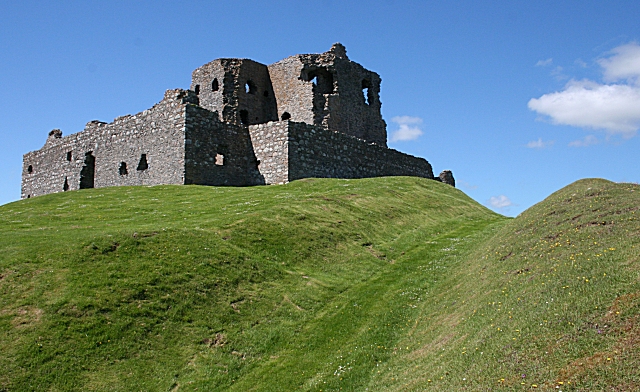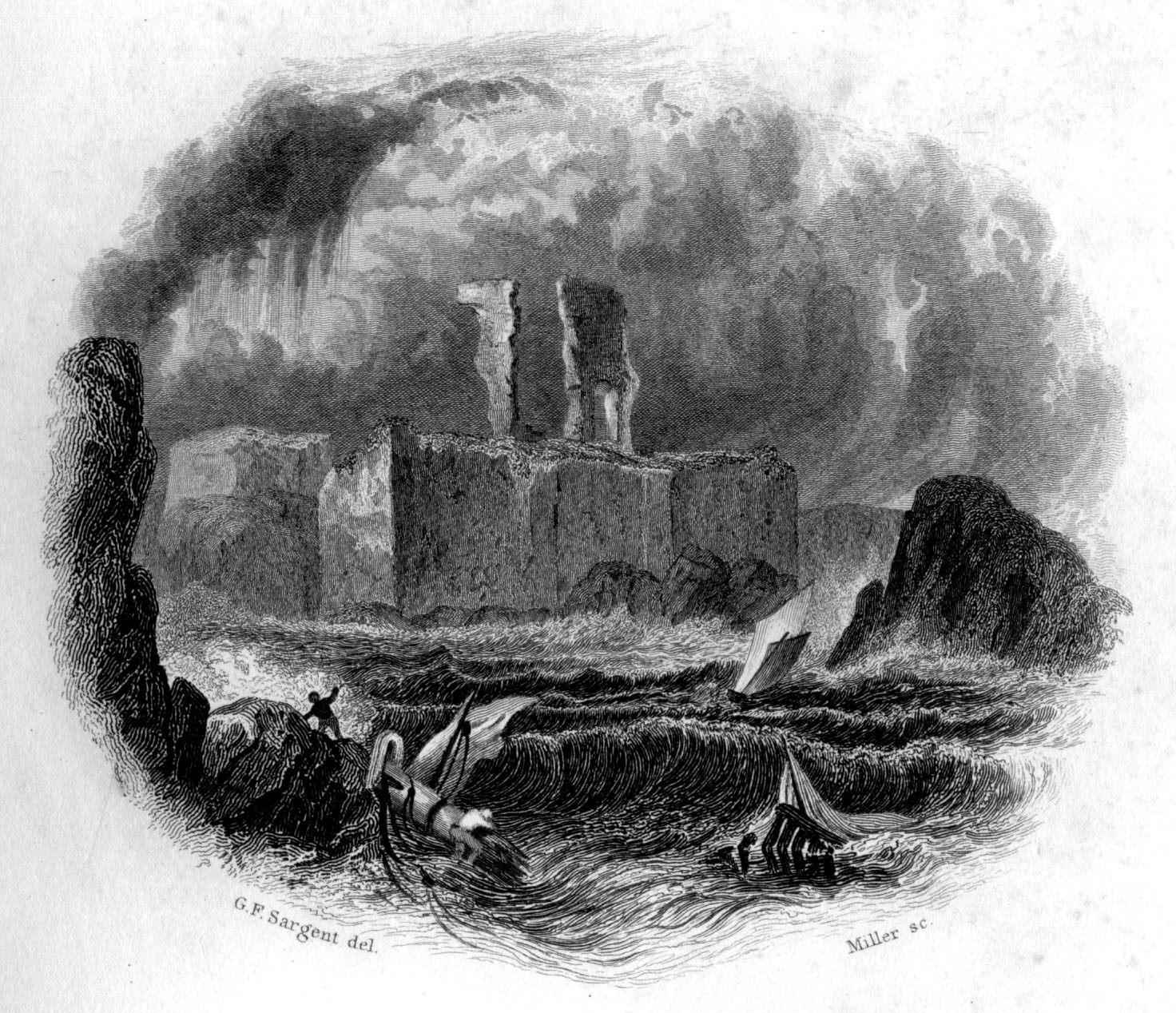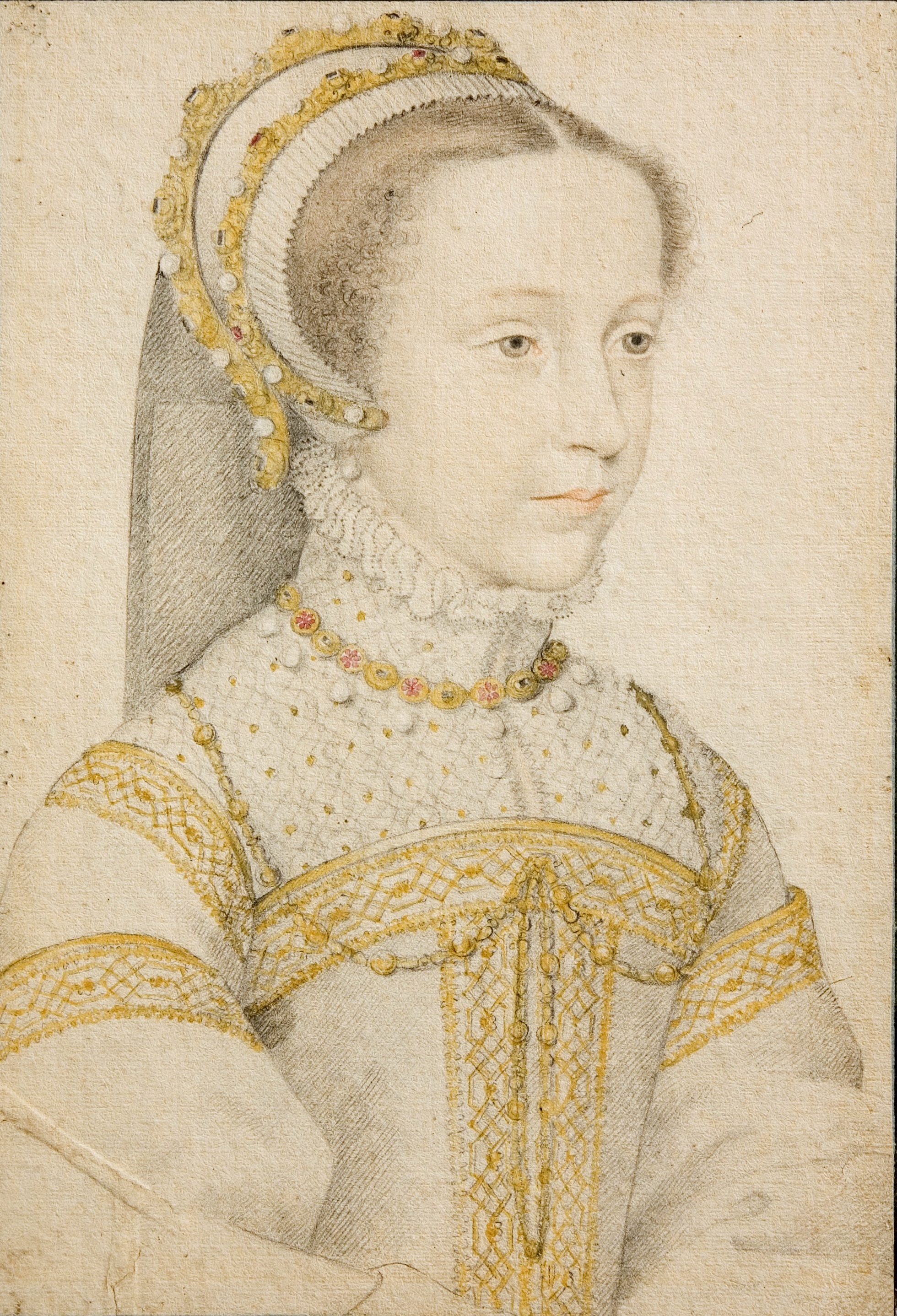|
Findlater Castle
Findlater Castle is the old seat of the Earl of Findlater, Earls of Findlater and Earl of Seafield, Seafield, sitting on a -high cliff overlooking the Moray Firth on the coast of Banff and Buchan, Aberdeenshire, Scotland. Location and etymology It lies about west of Banff, Scotland, Banff, near the village of Sandend, between Cullen, Moray, Cullen and Portsoy. The cliffs here contain quartz; the name "Findlater" is derived from the Scots Gaelic words ''fionn'' ("white") and ''leitir'' ("cliff or steep slope"). History The first historical reference to the castle is from 1246. Alexander III of Scotland, King Alexander III of Scotland repaired this castle in the 1260s in preparation for an invasion by Haakon IV of Norway, King Haakon IV of Norway. The Norwegians took and held the castle for some time. The castle remains that are still there are from the 14th-century rebuilding, when the castle was redesigned based on the Roslin Castle, Roslyn Castle model. Walter Ogilvy obtaine ... [...More Info...] [...Related Items...] OR: [Wikipedia] [Google] [Baidu] |
Banff And Buchan
Banff and Buchan is a committee area of the Aberdeenshire Council, Scotland, covering an area along the northern coast of the council area. The main towns are Banff and Fraserburgh. Fishing and agriculture are important industries, together with associated processing and service activity. Banff and Buchan was also the name of a district of Grampian Region between 1975 and 1996. The district covered a much larger area than the modern committee area. Its council was based in Banff. History The area has a long history of human occupation. Prehistoric features include a large long barrow at Longman Hill south-east of Macduff, as well as Cairn Lee to the west of Longman Hill. Local government district The Banff and Buchan local government district was created on 16 May 1975 under the Local Government (Scotland) Act 1973, which established a two-tier structure of local government across Scotland comprising upper-tier regions and lower-tier districts. Banff and Buchan was one o ... [...More Info...] [...Related Items...] OR: [Wikipedia] [Google] [Baidu] |
Roslin Castle
Roslin Castle (sometimes spelt Rosslyn) is a partially ruined castle near the village of Roslin, Midlothian, Roslin in Midlothian, Scotland. It is located around south of Edinburgh, on the north bank of the River Esk, Lothian, North Esk, only a few hundred metres from the famous Rosslyn Chapel. There has been a castle on the site since the early 14th century, when the Clan Sinclair, Sinclair family, Earl of Caithness, Earls of Caithness and baron of Roslin, Barons of Roslin, fortified the site, although the present ruins are of slightly later date. Following destruction during the The Rough Wooing, War of the Rough Wooing of 1544, the castle was rebuilt. This structure, built into the cliffs of Roslin Glen, has remained at least partially habitable ever since. The castle is accessed via a high bridge, which replaced an earlier drawbridge. Roslin was renovated in the 1980s and now serves as holiday accommodation. History The first castle was built in either the late 14th or in ... [...More Info...] [...Related Items...] OR: [Wikipedia] [Google] [Baidu] |
Castles In Aberdeenshire
A castle is a type of fortified structure built during the Middle Ages predominantly by the nobility or royalty and by military orders. Scholars usually consider a ''castle'' to be the private fortified residence of a lord or noble. This is distinct from a mansion, palace, and villa, whose main purpose was exclusively for ''pleasance'' and are not primarily fortresses but may be fortified. Use of the term has varied over time and, sometimes, has also been applied to structures such as hill forts and 19th- and 20th-century homes built to resemble castles. Over the Middle Ages, when genuine castles were built, they took on a great many forms with many different features, although some, such as curtain walls, arrowslits, and portcullises, were commonplace. European-style castles originated in the 9th and 10th centuries after the fall of the Carolingian Empire, which resulted in its territory being divided among individual lords and princes. These nobles built castles ... [...More Info...] [...Related Items...] OR: [Wikipedia] [Google] [Baidu] |
Cullen House
Cullen House is a large house, about south-west of the coastal town of Cullen, Moray, Cullen in Moray, Scotland. It was the Family seat, seat of the Clan Ogilvy, Ogilvies of Findlater, who went on to become the Earl of Seafield, Earls of Findlater and Seafield, and it remained in their family until 1982. Building work started on the house in 1600, incorporating some of the stonework of an earlier building on the site. The house has been extended and remodelled several times by prominent architects such as James Adam (architect), James Adam, John Adam (architect), John Adam, and David Bryce. It has been described by the architectural historian Charles McKean as "one of the grandest houses in Scotland" and is designated a Category A listed building. The grounds were enlarged in the 1820s when the entire village of Cullen, save for Cullen Old Church, was demolished to make way for improvements to the grounds by Ludovick Ogilvy-Grant, 5th Earl of Seafield; a new village, closer to ... [...More Info...] [...Related Items...] OR: [Wikipedia] [Google] [Baidu] |
James Ogilvy, 1st Earl Of Findlater
James Ogilvy, 1st Earl of Findlater (1592–1652), known as Lord Ogilvy of Deskford until 1638, was a Scottish nobleman and Royalist supporter. G.E. Cokayne; et al: ''The Complete Peerage of England, Scotland, Ireland, Great Britain and the United Kingdom, Extant, Extinct or Dormant, new ed.'' (1910-1959; reprint in 6 volumes, Gloucester.: Alan Sutton Publishing, 2000), volume V, p. 381Balfour Paul, Sir James (1904). ''The Scots Peerage''. Vol. IV. David Douglas. pp. 26–28 His title was named after Findlater Castle, the ancient seat of the Ogilvies of Deskford and Findlater, a branch of Clan Ogilvy. Despite being a Royalist, he was described as " otprepared to go to war for he King. Instead Lord Findlater attempted to keep the peace in the north-east of Scotland, peacemaking between Huntly's supporters and the Covenanters. He was the son of Walter Ogilvy, 1st Lord Ogilvy of Deskford and Lady Mary Douglas. He married Lady Elizabeth Leslie, daughter of Andrew Leslie, 5th Earl of ... [...More Info...] [...Related Items...] OR: [Wikipedia] [Google] [Baidu] |
Battle Of Corrichie
The Battle of Corrichie was fought on the slopes of the Hill of Fare in Aberdeenshire, Scotland, on 28 October 1562. It was fought between the forces of George Gordon, 4th Earl of Huntly, chief of Clan Gordon, and the forces of Mary, Queen of Scots, under James Stewart, 1st Earl of Moray. Huntly had defeated the English twenty years earlier at the Battle of Haddon Rig; however, at Corrichie he was defeated by Queen Mary's forces, and apparently he died of apoplexy after his capture. Mary had come in person to the north of Scotland intent on confronting the power of the Gordons. At Corrichie, the Gordons' tactic of charging with swords was defeated by Moray's Pike square, pike drill. Context George Buchanan described the events of 1562 in his ''History of Scotland''. The Earl of Huntly had lost the earldoms of Moray and Mar, which he considered his heritage, and became an enemy of the new Earl of Moray, the half-brother of Mary, Queen of Scots. Mary and Moray arrived at Aberdee ... [...More Info...] [...Related Items...] OR: [Wikipedia] [Google] [Baidu] |
Auchindoun
Auchindoun Castle is a 15th-century L-Plan tower castle located in Auchindoun near Dufftown in Moray, Scotland. History While there is evidence of prehistoric or Pictish earthworks in the grounds of the castle, the remains most visible today are of the castle constructed in the mid-15th century. This building is sometimes said to be the work of Robert Cochrane, a favourite of James III. It passed to the Clan Ogilvy in 1489 and from them to the Clan Gordon in 1535.Coventry (2008). p. 228. There are accounts, including by William Forbes Skene and Alexander Macbain, that state that William Mackintosh, 15th of Mackintosh had burned the Earl of Huntly's Auchindoun Castle which is why Huntly had him executed in 1550. However, Alexander Mackintosh-Shaw states that this story is entirely fictitious. The castle was damaged by the Clan Mackintosh in 1592 in retaliation for Huntly's killing of the '' Bonny Earl O'Moray'', their ally. In March 1593 Patrick Gordon of Auchindoun was f ... [...More Info...] [...Related Items...] OR: [Wikipedia] [Google] [Baidu] |
Dunbar Castle
Dunbar Castle was one of the strongest fortresses in Scotland, situated in a prominent position overlooking the Dunbar Harbour, harbour of the town of Dunbar, in East Lothian. Several fortifications were built successively on the site, near the English-Scottish border. The last was slighting, slighted in 1567; it is a ruin today. Structure The body of buildings measured in excess of from east to west, and in some places up to from north to south. The South Battery, which Grose supposes to have been the citadel or keep, is situated on a detached perpendicular rock, only accessible on one side, high, and is connected to the main part of the castle by a passage of masonry measuring . The interior of the citadel measures within the walls. Its shape is octagonal. Five of the gun-ports remain, which are called the 'arrow-holes'. They measure at the mouth and only at the other end. The buildings are arched and extend from the outer walls, and look into an open court, whence th ... [...More Info...] [...Related Items...] OR: [Wikipedia] [Google] [Baidu] |
James Ogilvy, 5th Lord Ogilvy Of Airlie
James Ogilvy, 5th Lord Ogilvy of Airlie (died 1606) was a Scottish landowner and diplomat. Life Ogilvy was the son of James, Master of Ogilvy, and Katherine Campbell, Countess of Crawford, a daughter of Sir John Campbell of Cawdor. His father, the Master of Ogilvy, was killed in 1547 at the Battle of Pinkie and his mother became the tutor to her children. His home was Airlie Castle, which he planned to rebuild or extend in 1564. In April 1587 Ogilvy wrote to Patrick Vans of Barnbarroch recommending his servant Robert Bruce to join an embassy to Denmark, because they had both recently been in Denmark. James VI was invited to Denmark in May 1596 by the ambassador Steen Bille to attend the coronation of his brother-in-law Christian IV. He appointed Lord Ogilvy and Peter Young as his ambassadors to go in his place, because his wife Anne of Denmark was pregnant, and they were accredited by Christian IV in a letter dated 6 August 1596. James VI rode from Falkland to Dundee to see ... [...More Info...] [...Related Items...] OR: [Wikipedia] [Google] [Baidu] |
George Gordon, 4th Earl Of Huntly
George Gordon, 4th Earl of Huntly (151428 October 1562) was a Scottish nobleman. Life He was the son of John Gordon, Lord Gordon, and Margaret Stewart, daughter of James IV and Margaret Drummond. George Gordon inherited his earldom and estates in 1524 at age 10. As commander of the King's Army he defeated the English at the Battle of Haddon Rig in 1542, was a member of the council of Regency under James Hamilton, 2nd Earl of Arran and Cardinal Beaton and succeeded as Chancellor on the murder of Beaton in 1546. He was captured at the Battle of Pinkie Cleugh in 1547, and held in the Tower of London but in autumn 1548 he was released when a ransom was delivered by Robert Carnegie, Lord Kinnaird. In 1550, he accompanied queen Mary of Guise to France. He joined the Protestant Lords of the Congregation in 1560, although he was "a late, reluctant, and unreliable recruit". He was a religious conservative, however, and he worked for "a form of co-existence between Catholic and ... [...More Info...] [...Related Items...] OR: [Wikipedia] [Google] [Baidu] |
Mary, Queen Of Scots
Mary, Queen of Scots (8 December 1542 – 8 February 1587), also known as Mary Stuart or Mary I of Scotland, was List of Scottish monarchs, Queen of Scotland from 14 December 1542 until her forced abdication in 1567. The only surviving legitimate child of James V of Scotland, Mary was six days old when her father died and she inherited the throne. During her childhood, Kingdom of Scotland, Scotland was governed by regents, first by the heir to the throne, James Hamilton, Earl of Arran, and then by her mother, Mary of Guise. In 1548, she was betrothed to Francis II of France, Francis, the Dauphin of France, and was sent to be brought up in Kingdom of France, France, where she would be safe from invading Kingdom of England, English forces during the Rough Wooing. Mary Wedding of Mary, Queen of Scots, and Francis, Dauphin of France, married Francis in 1558, becoming queen consort of France from his accession in 1559 until his death in December 1560. Widowed, Mary Entry of Mary, Q ... [...More Info...] [...Related Items...] OR: [Wikipedia] [Google] [Baidu] |
Mary Of Guise
Mary of Guise (; 22 November 1515 – 11 June 1560), also called Mary of Lorraine, was List of Scottish royal consorts, Queen of Scotland from 1538 until 1542, as the second wife of King James V. She was a French people, French noblewoman of the House of Guise, a cadet branch of the House of Lorraine and one of the most powerful families in Kingdom of France, France. As the mother of Mary, Queen of Scots, she was a key figure in the political and religious upheaval that marked mid-16th-century Kingdom of Scotland, Scotland, ruling the kingdom as List of regents#Scotland, queen regent on behalf of her daughter from 1554 until her death in 1560. The eldest of the twelve children born to Claude, Duke of Guise, and Antoinette of Bourbon, in 1534 Mary was married to Louis II d'Orléans, Duke of Longueville, the Grand Chamberlain of France. The marriage was arranged by King Francis I of France, but proved shortlived. The Duke of Longueville died in 1537, and the widower kings of Kingd ... [...More Info...] [...Related Items...] OR: [Wikipedia] [Google] [Baidu] |





